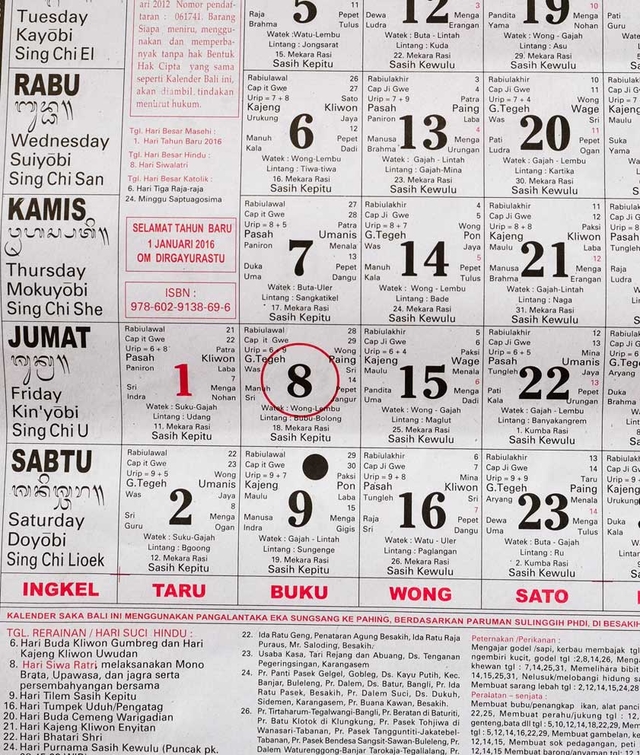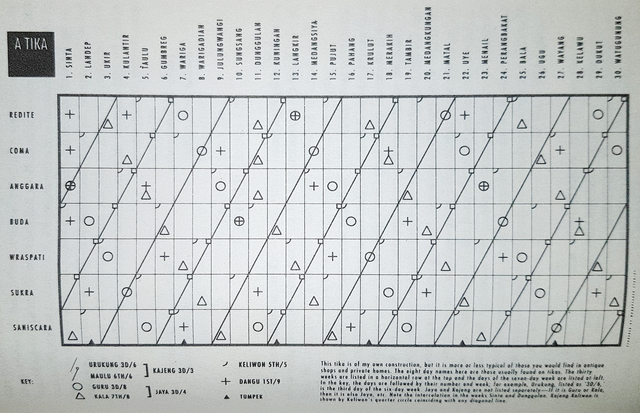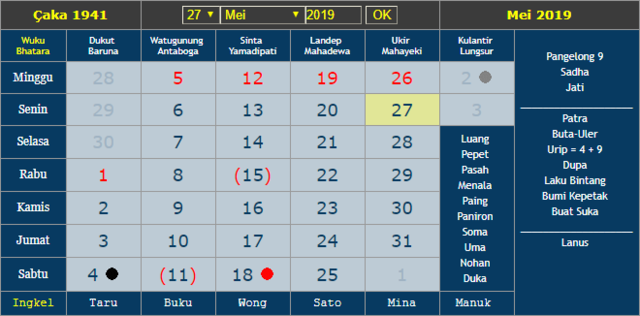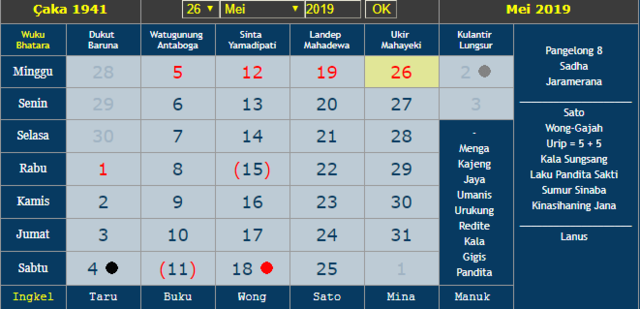
How often do we ponder over how familiar things and phenomena can take on unexpected facets? This is especially evident when traveling. We explore the traditions of other countries, their culture, and religions.
We understand that funeral customs, fasting methods, coming-of-age ceremonies, marriage initiation rules can be completely different. Ones that might be hard for us to imagine until we come face to face with them.
In this sense, Balinese culture is a treasure trove of incredible discoveries. At every turn, it presents some surprises. Teeth filing, the day of silence, battles on sharp pandan leaves, burying the deceased under trees, the prohibition of touching another person's head, the tradition of embedding a ritual blade into one's body – these are the most obvious that come to mind.
But we rarely think about how intricate the Balinese calendar system is. What does one know about the Balinese calendar with only a slight touch on the subject?
That there are two Balinese calendars – one is the Saka, which marks the day of silence (Nyepi) and is used for counting years, and another is Pawukon, which consists of 210 days and has major celebrations like Galungan and Kuningan, when according to Balinese beliefs, ancestral spirits descend to Earth.
210 days is not the most curious feature of the Pawukon calendar that one might encounter while studying it. Surprise follows surprise.
Surprise 1: Pawukon is not actually a Balinese calendar.
This calendar was brought to Bali in the 14th century by representatives of the fleeing Javanese dynasty of Majapahit, who resettled on Bali, bringing with them their culture, traditions, and authority.
Surprise 2: Pawukon doesn't have a year count.
Pawukon can be considered a calendar, or it can be seen as a system of cycles. It's a system that informs Balinese people about the dates of important religious holidays and auspicious days for certain actions, as well as inauspicious days. The cycles or years of Pawukon are not numbered in any way.
Surprise 3: There are 10 types of weeks in a Pawukon year.
In this calendar, there are weeks ranging from 1 to 10 days in length. All of these weeks run almost simultaneously, with the days of one week intersecting with the days of other weeks. These intersections create holidays on important days. A clear example might be our well-known "Friday the 13th," where the coincidence of two different cycles creates a "special day" for us.
Surprise 4: Not all weeks are equally significant.
The most important and key weeks for assigning holidays are the three-day, five-day, and seven-day weeks. The significance of the three and five-day weeks arose from their indication of market days on Java and Bali. Markets were held every three days in Bali and every five days on Java. Thus, these cycles of three-day and five-day weeks emerged.
Surprise 5: Weeks have distinct names based on the number of days.
These names originated from Sanskrit and use numerals from that language. For instance, the three-day week is called "Trivara," the five-day week is "Pancavara," and the seven-day week is "Saptavara."
Surprise 6: Each day of different weeks has its own unique name.
Days of the three-day week (Trivara) are named:
- Pasah
- Beteng
- Kajeng
Days of the five-day week (Pancavara) are named:
- Umanis
- Paing
- Pon
- Wage
- Keliwon
Days of the seven-day week (Saptavara) are named:
- Redite - corresponds to our Sunday
- Soma - corresponds to our Monday
- Anggara
- Budha
- Wraspati
- Sukra
- Saniscara

Surprise 7: Each week of the seven-day cycle has its own name according to its position in the Pawukon calendar year. I won't burden you with a lengthy list of all 30 week names, which you're unlikely to read and memorize, but the Pawukon cycle starts with the week named "Sinta" and ends with the week "Watugunung." You can observe this sequence on a special "tika" calendar, where the days of the week are listed vertically, and the 30 weeks of the calendar are listed horizontally.
An important week in the calendar is the 11th week, "Dunggulan," during which the major Balinese holiday of Galungan is celebrated. The 12th week marks the Kuningan holiday, signifying the conclusion of the festive events related to Galungan.


Surprise 8: The arrangement of dates on the Balinese calendar is different.
We are accustomed to reading our calendars from left to right, moving on to the next line below in the same manner. The Balinese calendar, however, reads the line from top to bottom and then proceeds to the next line on the right.
Surprise 9: The Balinese calendar includes all day names for all its weeks.
Around the number corresponding to the date on our calendar, the names of the day in different week systems are arranged. However, there are slightly different editions of calendars that arrange the day names in the 1st, 2nd, 3rd, and so on days of the week slightly differently. Therefore, without a good understanding of the day names in the week, it may be challenging to immediately figure out.

The Balinese online calendar from the website http://kalenderbali.org is very convenient in this regard. All the names of the current day are listed in a column right after the calendar. For example, on May 27th, the day has the following names:
- Luang
- Pepet
- Pasah
- Menala
- Paing
- Paniron
- Soma
- Uma
- Nohan
- Duka
According to the systems of the 1st, 2nd, 3rd, 4th, 5th, 6th, 7th, 8th, 9th, and 10th days of the week.
Surprise 10: Not all days of the week follow one another in sequence.
Imagine if you had a two-day week consisting of Monday and Tuesday, and they alternated like this.
Imagine if you had a two-day week consisting of Monday and Tuesday, and they alternated like this.
Mon Mon Tue Mon Tue Tue Tue
Tue Tue Mon Mon Mon Mon Mon
Mon Tue Tue Tue Tue Tue Mon
Tue Mon Mon Mon Tue Mon Tue
Mon Tue Mon Tue Mon Tue Mon
How could anyone come up with such an order in the first place? This question leads to yet another surprise.
Surprise 11: The order of days in the two-day week is determined by summing the numbers assigned to the days of the five-day and seven-day weeks.
The days of the five-day week have ritual numbers ("urip") assigned to them in the following order:
- Umanis - 5
- Paing - 9
- Pon - 7
- Wage - 4
- Keliwon - 8
The 7-day week has the following numbers:
- Redite - 5
- Soma - 4
- Anggara - 3
- Budha - 7
- Wraspati - 8
- Sukra - 6
- Saniscara - 9
And here's how the calendar experts worked: they took a specific day, looked at which day it corresponded to in the five-day week and which number, and similarly in the seven-day week, then added these two numbers. If the result was even, the day was named "Menga," and if it was odd, the day was named "Pepet."
Let's take May 26, 2019, for example. In the five-day week, this day corresponds to "Umanis," and it is assigned the number 5. In the seven-day week, it corresponds to "Redite," and it is also assigned the number 5. 5 + 5 = 10, so in the two-day week, May 26 is named "Menga."

Surprise 12: There are days when one of the week types is missing.
Yes, this is one of the most peculiar weeks - the one-day week. Its sole day is named "Luang." It falls on days when the sum of the numbers corresponding to the values in the five-day and seven-day weeks is odd.
It's not difficult to guess that if a day is "Pepet" in the two-day week, it is also "Luang." And if it's "Menga," then there is no "Luang" day in the one-day week.
May 26, 2019, is a vivid example of such a day. Do you see in the column at the end of the calendar that the day names of the week start with "Menga"? That's precisely because there is no one-day week on May 26.

This dozen is far from all the surprises of the Balinese calendar. There are still many more, and we will continue exploring them in this topic.
P.S. Have you already felt the desire to get yourself a Balinese calendar for your home?
You can add one right now!